Chuck Wendig's Blog, page 28
August 19, 2022
Alan Baxter: Sallow Bend, and The Power of Small Town Horror
What is it about small town horror? Why is it so godsdamned compelling? Good horror can happen anywhere. I’ve written city-based urban horror and international thriller-type horror as well as small town. There’s super famous horror set in the Arctic or the jungle or any number of other locales. A good dark yarn can be spun in any environment. But there’s something particularly delicious about hamlet hideousness. Why?
For many of us who live in or near such places, we see some of the more mundane horrors on a daily basis. I mean, you live in a place where almost everyone knows who you are—that’s terrifying. The level of gossip that circulates a small community like scum slowly circulating a partially-blocked drain, is appalling. But these are indeed everyday horrors.
The small town has its edge, I think, due to several other factors. For one, it shares its tight-knit community with some degree of isolation. After all, if it wasn’t isolated it would be a suburb. The fact that it stands alone is what denotes its identity. And that allows a certain culture to build up. Every small town has a vibe. An accent. A unique weirdness. Mostly they’re entirely benign. Maybe they’re great for antique shopping, or farm produce. Perhaps they have particularly interesting trees. Or maybe, like Snowtown in South Australia, they’re great for bodies stuffed into barrels. (In case you don’t know about that one, the short version is that between 1992 and 1999, three guys murdered 12 people and, with the help of a 4th person, hid all the bodies in barrels in an abandoned bank vault in Snowtown, about 87 miles north of Adelaide. None of the killers or victims were actually from Snowtown, but the town carries the stigma to this day.)
It’s that combination of peculiar local culture and isolated location that lets small towns develop into genuine horrors, if we let them. When I wrote The Gulp and The Fall I leaned hard into that concept—Gulpepper is a small harbour town on the coast of New South Wales in Australia that some maps don’t even show. That town is weird with a capital WEIRD. I got to build an entire mythology around its weirdness which allowed me to tell all kinds of wild stories, and I’m not finished yet. There’ll be more Tales From The Gulp one day.
I wanted to visit that idea again with Sallow Bend, my latest novel coming out through Cemetery Dance Publications on September 2nd. But where Gulpepper is truly weird, Sallow Bend is a small town with a slightly different angle—this one is a pretty regular place, only it has a dark and forgotten history. Forgotten except that it periodically repeats, and at the start of the novel it’s beginning to come around again. That history best left unspoken is another aspect that makes the small town intriguing and potentially frightening. It’s small, isolated, with a dark past…
Where the isolation of the small town allows strange culture to build, it also provides a kind of trap when things go awry. In the city, the police are usually not far away (although they might shoot you simply for calling them, but that’s an entirely different strain of horror). In the city, you can jump on a bus or a train or hail a cab and leg it. In the city, there’s usually cell phone coverage. In the city you can get lost in the crowd and spend most of your time unnoticed. In a small town, the cops are very far away. In a small town there’s no public transport to help you get away (where I live there’s a bus once per hour on weekdays between 9am and 6pm—good luck if the monster is after you in the evening, or you just missed the last bus and have to wait another hour.) In a small town there are often cell phone dead spots—honestly, those places piss people off but they’re a fucking godsend for horror writers. In a small town, you can’t do anything without someone seeing you and taking note. And there’s another aspect of the horror we draw on.
“Oh, I noticed young Charlie wasn’t in school on Tuesday. Perhaps he’s dying of some rare terminal childhood disease!” Yeah, or maybe he had a dentist appointment.
“Hey, I saw old Mr. Crackerjack taking a lot of money out of the bank on Friday. I wonder if he’s paying off some terrible debt? Or hiring a hitman to take out Mrs. Crackerjack?” Yeah, or maybe he needs a new car.
Honestly, the gossip machine is out of control in local communities. But that’s the thing about the small town community—any of those explanations could be true, from the boring to the infernal. The people can have as many dark secrets as the place. Someone might be as sweet as pie or a cannibal who wants to eat your lips, sauteed in a nice onion and garlic sauce. Your lovely neighbour might indeed be dear old Mrs. Flowerpot, who runs the Country Women’s Association and makes delicious orange marmalade cake, or she might be dear old Mrs. Flowerpot, who runs the Country Women’s Association and makes delicious orange marmalade cake and is also a slimy swamp beast wearing the original Mrs. Flowerpot’s skin like an ill-fitting suit. “Do come in for a nice, moist slice of cake dear, then I’ll trim off those full lips of yours and fry them up with onions and garlic.”
Small towns are often old too, therefore packed with haunted places. There are a million apocryphal stories passed on by generation after generation that make city-based urban legends seem like children’s stories. When people see everything that goes on, it’s easy to speculate about your neighbours and the best speculation involves all manner of things sinister and cruel. Despite the idea that small towns are friendly and supportive (which, to a large degree, they often are) they frequently also create sharply opposed cliques, groups at loggerheads with each other about any number of issues, small or large. This engenders all kinds of potential conflict. Now the town is small, isolated, with a dark past, and there are factions and gossip running rife. Who fits where? And why? Or why not?
But the idea of fitting in often brings those communities together on one subject: their disdain for the outsider. Their distrust of anyone not local. That alone creates some wonderful fodder for horror. But what if you’re part of that community but also, somehow, always seen as the outsider?
Equally, of course, the disdain can run the other way, with urban folk sneering at the backwards simpletons in the country. Well, that’s all very well, Chad, until you go for a weekend antiquing and your cell phone has no coverage and dear Mrs. Flowerpot is eating your lips. Sucked in, Chad!
Small town horror has been around forever, and some of our favourite horrors are small town ones. Think of movies like A Nightmare on Elm Street, Halloween, Scream, or The Lost Boys. TV like Midnight Mass, Stranger Things, Buffy the Vampire Slayer, League of Gentlemen, or Gravity Falls. And of course books, like Stephen King’s Salem’s Lot, Needful Things or IT, Peter Straub’s Ghost Story, Shirley Jackson’s We Have Always Lived in the Castle, Josh Malerman’s Goblin, Jennifer McMahon’s The Winter People, and so many more. Plus, of course, my own books like The Gulp and The Fall, and now my new one, Sallow Bend. All these examples are just a random selection off the top of my head, and even there you can see such a wide range of horror styles. The genre is indeed a truly broad church, from the blood-soaked to the deeply disquieting and everything in between.
I think small town horror has a place deep in our souls, and I have a theory as to why, beyond the obvious one that it’s just super entertaining and hella creepy. Just maybe it’s because, no matter where we live or were born or grew up, we’re each a kind of small town ourselves, existing in our isolated brain-mind-trapped-in-a-meat-bag state. The locations of these horrors are small, isolated, with a dark past, and there are factions and gossip running rife, and people who don’t fit in. That only serves to highlight our own fears of insignificance, isolation, forgottenness, otherness, with our secrets we don’t want others to know, and a terror of not fitting in, or just being too fucking weird. Perhaps therefore, these stories reflects some of the most deep-seated issues we all carry with us, consciously or not.
But take comfort, friend, because the other thing horror does so well is help us face the darkness. It helps us interrogate our fears. It’s cathartic and emboldening. And while we might each be a little isolated weirdo, we can all be isolated weirdoes together in our love of this wonderful genre. I hope you enjoy some small town horror soon, you brain-mind-trapped-in-a-meat-bag, you.
Sallow Bend comes out through Cemetery Dance Publications on September 2nd and pre-orders are live now. Learn more about it and everything else Alan Baxter at www.alanbaxter.com.au
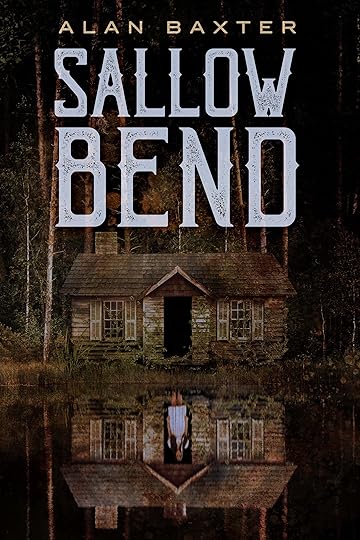
August 18, 2022
Kate Heartfield: Five Things I Learned Writing Assassin’s Creed: The Magus Conspiracy
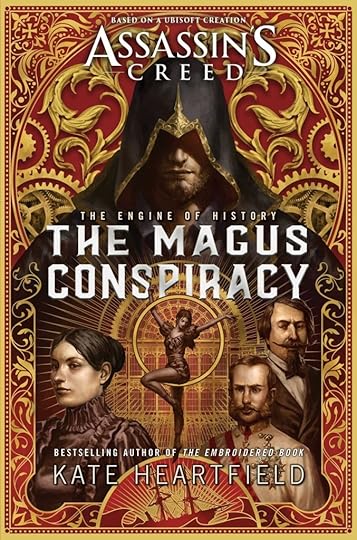
The war between Assassins and Templars wreaks havoc in the Victorian era, in this breakneck thriller which opens up a whole new chapter of the Assassin’s Creed universe.
London, 1851 – When Pierrette, a daring acrobat performing at the Great Exhibition, rescues the mathematician Ada Lovelace from a gang of thugs, she becomes immersed in an ancient feud between Assassins and Templars. But Lovelace is gravely ill, and shares her secrets with Pierrette, sending the acrobat in search of a terrible weapon which she’d been developing for a shadowy figure known as “the Magus”. Pierrette’s only ally is Simeon Price, Lovelace’s childhood friend, who belongs to a Brotherhood devoted to free will. With Simeon’s aid, they uncover a startling web of political assassinations destabilizing Europe. As they race to foil the Templars’ deadly plot, murders and bombs are everywhere they look, but hope is nowhere in sight.
Nothing Is True; Everything Is PermittedPlayers of the Assassin’s Creed videogames will recognize this as the maxim that guides the game’s ancient brotherhood. The basic idea is that rules are made up, and what is true in one place or time may not be in another, and what should guide an individual’s behavior is consideration of the consequences. This is also pretty good writing advice, as it happens! There are no rules, there’s only what works to achieve your goals and what doesn’t. I knew that already, but I need a reminder from time to time.
When I realized that this book would work much better if I moved one of the chapters earlier and slightly out of timeline, and the best way to flag that for the reader would be to call it a prologue, I hesitated, for a couple of reasons.
The first was that prologues have their haters. A lot of people have translated “sometimes prologues are unnecessary padding” to “prologues are always unnecessary and annoying.” So that made me pause to consider whether I was ready to risk the consequence of some readers skipping what is, in fact, a integral part of the book that’s just told out of sequence for several reasons.
But ultimately, the only consequence that matters is: “is the book as good as it can be?” I knew the story would unfold better in the order I wanted to tell it. I can’t control the way readers will interact with a book, but I can control my decisions as a writer.
The second reason I hesitated was that my original plan for the book didn’t have that chapter appear in the beginning as a prologue. But an outline isn’t sacred. (Although with tie-in writing such as books based on videogames and movies, changes may need to be approved.) An outline is only “true” as far and as long as it serves you.
We Work in the Dark to Serve the Light“Everything is permitted” is all fine and good when it comes to whether or not to write in second person or write your novel in verse – fill your boots – but it’s a little more complicated when we’re talking about the actual Assassin’s Creed, because what’s permitted in that case is, well, killing people. The creed is full of paradoxes. Assassins push back against dogma, but they act on faith themselves, and have a set of rules to obey. They don’t kill innocents or harm their brotherhood; but who decides who is innocent, and what constitutes harm?
Yes, awareness of consequences can guide to morality – but every individual comes to the world with their own knowledge and character. We can see this all around us in how people respond to the pandemic and weigh the consequences of something like not wearing a mask in a crowd. Societies have rules for a reason. But then, of course, someone has to set and protect those rules, and those people are also fallible…
In the Assassin’s Creed universe, these questions are frequently debated by the characters themselves – and the only thing that’s certain is that nothing is. Both the main characters in The Magus Conspiracy are internally divided, pulled in multiple directions at once, forced to make moral decisions that sometimes turn out to be mistakes. I wanted my characters to have plenty of chances to explore the philosophical underpinnings of the games (sorry, characters).
Games and stories about larger-than-life, morally grey characters and situation are entertaining. But more than that, writing characters who have extreme choices to make (like whether or not to stab someone) can help illuminate the less dramatic moral choices we all make every day.
Hide in Plain SightI wanted the reader to be involved and engaged in those choices too. Reading a book isn’t a passive activity, and reading a videogame book really shouldn’t be.
One of the ways a novel can heighten that sense of participation in the reader is to include a mystery or a twist to figure out. There’s a mystery at the heart of The Magus Conspiracy. But writing twists always makes me a bit nervous, because I’m one of those people who tends to spot them early (or at least I think I do!). When the twist is all there is, it can feel anticlimactic to just have it confirmed that yep, it’s what you thought it was on page 3, or in the first five minutes. Alternatively, sometimes giving a reader red herrings can create a different kind of disappointment. I’ve sometimes reached the end of a book or movie and learned that the writer went with a solution that wasn’t as cool or satisfying as the thing I thought it would be.
So as I wrote The Magus Conspiracy, I asked myself all the way along how I could make sure to satisfy a reader who figured things out faster than my characters do – or who was quietly rooting for a different twist. I laid my trail of breadcrumbs for the reader, but I also assumed for the sake of argument a hypothetical reader who guessed the destination of that trail right away, whether the guess turned out to be the same as the ultimate revelation or not. What sort of tension, what further layers of mystery, could I include? How could I make the “why” or the “how” or the “oh no” into a ball of yarn just as fun to play with as the mystery itself?
We Must Be the Shepherds of Our Own CivilizationThe character Ezio Auditore says this in one of the Assassin’s Creed games, and it kept coming back to me as I was writing The Magus Conspiracy.
One of the key thematic questions of the Assassin’s Creed franchise is the role of order and authority, represented in the games by the Templar Order. The Assassins believe they are fighting for peace by pushing back against the Templar conception of authority. So exploring those questions in a novel set in early 1850s Europe seemed a natural fit.
The middle of the 19th century has a lot of parallels to our own time. The one that really grabbed me, as I was researching and writing this book, was the collapse of authority. There was widespread hunger in Europe in the 1840s; we mainly refer to this today as the Irish Potato Famine, where the consequences were extreme and were exacerbated by the British government, but there were shortages and rising prices throughout Europe. There was also a tech bubble – railroad speculation – that collapsed, leading to a financial crisis and, in the UK, a run on the banks. Like today, monetary policy was a hot topic – never a sign that things are going well.
In 2022, authority continues to not make a very good case for itself, in everything from public health to policing to the climate crisis to the economy. I have no idea which way things will go, but I found it very instructive researching the Hungry Forties and the years that followed. In 1848, Europe rose up in a series of revolutions that failed in most of their immediate aims, but changed the world significantly. The lesson of the 1840s is that order is not peace.
If You’re Going to Take a Leap of Faith, It Helps to Be Facing the Right DirectionOne of the things I learned in my research for this book is that Ada Lovelace was even more of a badass than I knew.
She’s best known for her annotations of Charles Babbage’s design of a proposed Analytical Engine that would be programmable in the much the same way a computer is. Her notes explained the significance of the concepts underlying the design, and even included a detailed example that is widely considered the first computer program.
What made her a great figure in the history of science was not expertise in mathematics or in any particular area, but her capacity for imagination, which she described as “the discovering faculty.” She thought of science as being an unseen world all around us. Once she had applied her imagination, making new connections between apparently unrelated things, she could “see” things no one else could. She talked about a “new language” and the “science of operations” as distinct from mathematics, in an age in which computers didn’t yet exist.
What I hadn’t realized was that her work with Babbage was only one of her many interests, and not even her biggest one. She corresponded with several scientists in various fields, and kept all sorts of notes about her plans and ideas – some of which were, frankly, a bit weird. She was interested in the science of music and talked about tantalizing, universal ideas just out of her reach. If she hadn’t been ill most of her life, if she hadn’t been plagued by creditors and bad guesses at the racetrack, if she hadn’t died of cancer at the age of 36, who knows what else she would have written and perceived?
But then again, maybe all those other avenues of inquiry into the various faddish sciences of the 19th century wouldn’t have led to other moments of equal greatness. Maybe the main thing is that she had an imagination that was ready to leap, and she happened to leap toward something sublime.
***
Kate Heartfield’s novel Assassin’s Creed: The Magus Conspiracy is published by Aconyte Books. Her novel The Embroidered Book, published earlier this year, a Sunday Times bestselling historical fantasy about Marie Antoinette and her sister, Maria Carolina. Kate’s novels, novellas, short stories and games have won or been shortlisted for several major awards, including three Nebula nominations in the novella and game writing categories. Her debut novel, Armed in Her Fashion, won Canada’s Aurora Award. She is a former journalist who lives near Ottawa, Canada.
Kate Heartfield: Website | Twitter
The Magus Conspiracy: Audio | Indiebound | Bookshop | Amazon | Aconyte
Bryan Young: Five Things I Learned Writing BattleTech: A Question of Survival
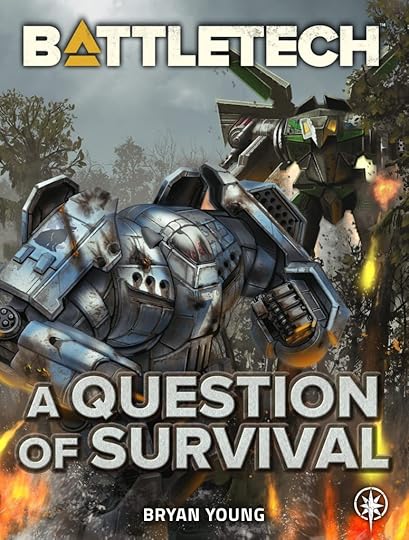
A FUTURE FOR THE TAKING…
As the last Bloodnamed Warrior left in the former Jade Falcon Occupation Zone, newly-elected Khan Jiyi Chistu has ’Mechs, but no MechWarriors—making it impossible to rebuild his Clan after the disaster on Terra. Meanwhile, despite being riven by the Dominion-wide vote on whether to join the new Star League or not, Star Colonel Emilio Hall’s Ghost Bears have a planet full of talented sibkos ready to graduate.
When word of these sibkos reaches Khan Chistu, he hatches a bold plan to take them, eager to rebuild the Jade Falcons. But with Star Colonel Emilio caught up in the politics of the Ghost Bear vote, will he even see Jiyi coming? Or will he lose the sibkos that represent the very future of his Clan?
For both men and the Clans they hold dear, these dilemmas become nothing less than a question of survival…
***
All stories are personal.
When I got to work on this book, I knew I was going to have to deal with the in-universe politics of BattleTech pretty heavily. For those unfamiliar with BattleTech, it’s a fairly warlike future where big stompy ’Mechs tend to do the diplomacy for people at the end of a gun. There are pockets of civilization, to be sure, but for the most part, people just want to shoot each other. At the outset of the book, the Ghost Bears, a segment of society that has settled into a part of the universe and been largely left alone for a long time, are forced to vote on whether or not they want to join up with something called the Star League Defense Force. It’s led by an unstable warrior named Alaric Ward of Clan Wolf and joining would seem not great. The entire population gets to vote and it gets ugly. Having a divisive vote that could very well end in civil war seems like it’s on a lot of people’s minds right now, given the last few decades of…well…the trashfires across the world. And I needed to make a way to make the politics feel relevant to people without seeming too overtly partisan. Going through and looking at how divisive elections happen on a small scale and affect individuals and families provided a much more interesting touch point than the sort of views I might have gotten just paying attention to the national news. Politics affect people deeply, even when they’re being misled, and it happens at the smallest of levels. It hits people personally. This book forced me to examine and interrogate that at a level I hadn’t considered.
Dueling protagonists heading toward each other like freight trains is a challenge, but fun to write (and read).
As you write, you get into your head that your story needs a protagonist and an antagonist. You always hear that your antagonist needs to be the protagonist of their own story. But what’s more fun than two co-protagonists heading toward each other, one an immovable object, one an unstoppable force? I’d never tried to write a story like this before and it quickly became an exciting challenge. Especially when these characters have such drastically different mindsets from both each other and me. How do I get into their heads and do them both a service of the protagonist treatment, even though they believe such drastically different things. It came down to the same things as the political story. I had to find the small things that made them human. For the head of the Jade Falcons, it was tapping into the twisted joy he felt for facing challenges. For the head of the Ghost Bear faction in this book, it was about tapping into their inner-life and approach to magnanimity in the face of losing things. Then, when you humanize them both and put them in conflict, it creates something greater than the sum of its parts.
Licensed universes require just as much craft and thought as any other form of writing.
It might not have been something I learned, but it’s definitely something that was reinforced as I set out to work on this latest book. Working in a licensed universe pushes and constrains you in ways that you don’t have to be contend with when you’re writing your own work. It’s a challenge on its own just to get the details right. You have to fit inside a world that already exists and that people already love, even if you have a fact check team behind you. Having guardrails of the universe actually forces you to thread a tighter needle and I think it creates (in some cases) more creative work. Every tool of craft you’ve learned over the years as a writer has to come to the forefront of what you’re doing so that you’re actually able to thread that needle. It’s so rewarding when it works.
Write the book you want to write.
It’s easy to be concerned about what the fans of a universe will say when they read your book. BattleTech has been alive and well since the ‘80s and there’s a long history there. Am I going to have anything to say that’s going to resonate with them? Or am I going to piss them all off? I really had to face that challenge by pushing those concerns away. Ultimately, I had to tell a story that I was proud of and that made sense to me and fit into the things I cared about. I included things in the book that I thought some fans might react poorly to, but they were important to me. At the end of the day, I wrote the book I wanted to write and I’m proud of it because I was able to push aside those worries about “fandom” and just tell a good story.
Make the story suspenseful, even if they know the ending.
There is a major event that occurs in my book that was actually revealed in a sourcebook that came out earlier this year. One of my main concerns in taking the writing assignment was that folks who had read the sourcebook wouldn’t find anything of interest in the story. Instead of falling into that trap, I had to get creative. I focused on the characters who had the most to lose by the event in question, and then carry the story beyond the threshold of the sourcebook. I had to make the events they already knew about compelling by making them care about the characters and adding new wrinkles to the story they hadn’t considered based on the original source. But, then again, I’m the sort of person who thinks prequels are great even though we know the ending: it’s the journey that counts.
***
Bryan Young (he/they) works across many different media. His work as a writer and producer has been called “filmmaking gold” by The New York Times. He’s also published comic books with Slave Labor Graphics and Image Comics. He’s been a regular contributor for the Huffington Post, StarWars.com, Star Wars Insider magazine, SYFY, /Film, and was the founder and editor in chief of the geek news and review site Big Shiny Robot! In 2014, he wrote the critically acclaimed history book, A Children’s Illustrated History of Presidential Assassination. He co-authored Robotech: The Macross Saga RPG and has written two books in the BattleTech Universe: Honor’s Gauntlet and A Question of Survival. He teaches writing for Writer’s Digest, Script Magazine, and at the University of Utah. Follow him on Twitter @swankmotron.
Bryan Young: Website | Twitter | Mailing List
A Question of Survival: Link
August 16, 2022
Nat Cassidy: Five Things I Learned Writing Mary, An Awakening Of Terror
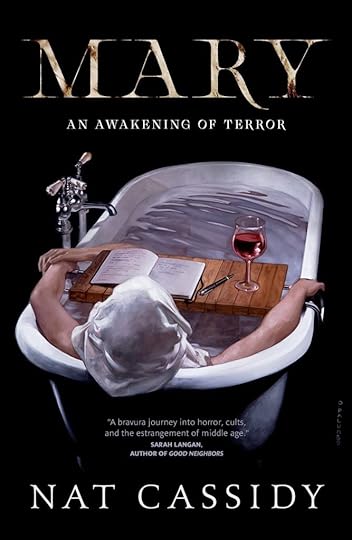
Mary is a quiet, middle-aged woman doing her best to blend into the background. Unremarkable. Invisible. Unknown even to herself.
But lately, things have been changing inside Mary. Along with the hot flashes and body aches, she can’t look in a mirror without passing out, and the voices in her head have been urging her to do unspeakable things.
Fired from her job in New York, she moves back to her hometown, hoping to reconnect with her past and inner self. Instead, visions of terrifying, mutilated specters overwhelm her with increasing regularity and she begins auto-writing strange thoughts and phrases. Mary discovers that these experiences are echoes of an infamous serial killer.
Then the killings begin again.
Mary’s definitely going to find herself.
***
Anyone who’s picked up a copy and flipped through even the introductory pages (say, at a brick-n-morty bookstore or on Ma & Pa Bezos’ Electric Book Emporium) will know that my new horror novel, Mary: An Awakening of Terror, has been a long time coming. I first wrote a version of this book when I was around 13 years old and carried the story with me for a full quarter of a century before finally tearing it off of my brainflesh like an engorged tick and hurling it into the marketplace.
Suffice it to say, then, I’ve learned a whole lot over the course of writing this book. I mean, I literally graduated middle school, high school, AND college. I moved to New York City. I became a professional playwright and actor. I learned how to cook with an Instant Pot. SO MANY LESSONS I COULD SHARE.
But I have a feeling there are others out there who, similarly, have a story they’ve been carrying with them for a while and, for whatever reason, haven’t gotten around to writing it yet. So I wanted to share five things I learned while writing Mary that are specifically about the process of finally writing a personal book that’s been a long time in the works—who knows, maybe this’ll help you remove and hurl that engorged braintick of your own? (And biggest thanks to Chuck, he of the Terriblest Mind and the Biggest Heart, for this space!)
1. YOU CAN FILL A SWIMMING POOL WITH A TEASPOON
When I was an active playwright (the clinical diagnosis), I had something of a reputation as being rather prolific, usually churning out 2 full-length scripts and an odd (very odd) assortment of short plays every year. Plus, my first published book was a novelization, and I managed to turn three full drafts of that 115K-word manuscript around in like 3-4 months total.
So imagine my surprise and horror when I got the contract to finally write Mary, and, for the first time in my professional life, the work … came out … excruciatingly … slow.
There were a number of factors. First off, it was a challenging story and a challenging character. It took a lot of work to figure out. That kind of work is hard and often very slow going.
But most of all, this was like RIGHT AS the pandemic was hitting, so the bulk of the book had to be written over that disorienting, distracting period of existential terror that was 2020. Then, as we seemed to be finally getting used to Pandemic Stasis, life decided to start kicking proverbial footballs to my proverbial groin. I was taking care of two elderly sick animals and running on, literally, 4 hours of sleep a night for almost two full years. My wife was all but bedridden due to excruciating, mysterious chronic pain. And, within a single calendar year, my mom, dad, mother-in-law, dog, AND cat, all died.
All of which is to say I wasn’t in the best mindset to write ANYTHING, let alone a debut original novel with a lot of personal baggage and pressure attached to it.
From contract to final draft, writing three drafts of Mary wound up taking something close to three years. My pub date had to be pushed back. I had to write agonizing updates to my editor and agent (both of whom were completely understanding—turns out this is far from uncommon). Compared to how I was used to working, this was a catastrophe.
But also, look: it got done! The book exists! You can go out and buy a copy of it right now! Seriously. Try it. You’re a rebel; they can’t stop you.
So I offer this first Thingilearned to anyone who is intimidated by the amount of writing needed to, well, write a book. Incrementalism works. On Twitter, sometimes it seems like every other writer churns out 5,000 words a day and then complains, ugh, I can’t believe I was soooo unproductive today! Smile politely at those writers and then IGNORE THEM.
You don’t have to write 5,000 words a day. You can write 5 words a day. It literally doesn’t matter as long as you keep at it. I mainly wrote Mary around 4:30 or 5am, in between walks for our sick dog. Most days I was so physically exhausted, so mentally drained, that I barely got a sentence or two on the page. But the cool thing about linear time is eventually those sentences will form an entire book. And that book will stand as a neon middle-finger to all those anxiety-filled days where you wondered if this thing was ever actually going to get finished.
2. PAPER CUTS
One funny(ish) thing about incrementalism, though, is you can start to lose track of the beast as a whole—refer to that super true story about the blind monks and an elephant (no, really, it happened to a cousin of a buddy of mine).
In Mary’s case, because the work was initially going so slowly, and I was so overwhelmed and intimidated by how much there was to do, I wound up making each chapter its own separate Word document, so I could feel like I was only working on a bite-sized project at a time. Hallelujah, it worked. I found it was so much easier to think about just this one story beat than everything else that lay beyond it.
Until it came time to paste all the separate documents together.
That’s when I realized I had a 180,000-word Frankenstein’s monster on my hands. For those who don’t know, these days the sweet spot for a horror/thriller is like 80-90,000—and Mary was always envisioned as an homage to Carrie, which is, like, 60,000 words! So, yeah, I’d, uh, gone a little overboard. I was going to have to cut. A. Lot.
I felt like the guy in Force Majeure, staring at an avalanche headed my way—how the hell was I going to do this? Well, as the adage about eating the elephant goes (coined, presumably, by hangry monks who were duped into that experiment referenced above): one bite at a time.
By this point in the pandemic, I was going back in to my dayjob office a few days a week and I was able to print a copy of the whole massive manuscript. Initially, I was worried that staring at that perilous pile of pages would be a deterrent, but I wound up discovering something amazing: almost all of the edits were fairly obvious now that I wasn’t forced to stare at a loathsome screen.
I wound up cutting over FIFTY THOUSAND WORDS outta the manuscript. To put it in Stephen King metrics, the final book is definitely not a Carrie. But I got it down from like Bag of Bones-length to Firestarter-length, which is no small accomplishment. (It’s actually one of the reasons I chuckle a little whenever someone says Mary is a long book. It’s not a short book, for sure, but boy what it COULDA been …)
So that’s my next Thingilearned: it is SO much easier to cut text on the page than it is on a screen. Your mileage may vary and all that, but from what I’ve gathered anecdotally from other writers, this is more often true than not.
I think it’s because reading your manuscript off a page starts to mimic the actual experience of what reading your final book will be like. We’re all critical readers—I have no doubt we all have a part of our brain that loves to chime in, “Here’s what I would do if I were writing this”—and seeing your EMBARRASSING early draft in this light helps you be more merciless and … well, critical. Being objective about your work is a challenge for any writer, but especially so when it’s a story you’ve carried with you for a long time, so anything you can do to create some distance is key.
Plus, my god, does crossing out entire pages feel goooooood. Even if you write really tight, fat-free fiction, do yourself a favor and add just a few extra pages of nonsense that you can cut. It’s a real high.
3. YOU KNOW YOUR STORY
Another side-effect of carrying a story with you for so long is it can become kinda like one of those katamari balls, rolling around in your subconscious, picking up all sorts of detritus: side characters, things you want to say, alternate plot branches that lead to alternate scenes that would be sooo cooool but might not fit with the overall story.
The raging war between the Plotters and the Pantsers is a conversation for another day (RIP to all our casualties on both sides), but for a project like this I would DEFINITELY recommend writing some sort of outline. Doesn’t matter how detailed, but try to give yourself a little structure. It’s almost like hiring a neutral arbiter: a third party that can help you determine what stuff stays and what stuff goes. And since an outline is basically a skeleton, that makes this a skeleton neutral arbiter, which is a legal procedural I would literally kill to see on network TV.
“But how will I know what stuff ultimately belongs in the story and what doesn’t?”
You won’t! But believe me when I say, the stuff that’s meant to stay in the story will find a way.
Case in point: as I said earlier, I first attempted writing this book when I was 13. And, before anyone gets too impressed, the version I wrote back then was … not good. There was barely any plot to it, just a mopey character moping around, watching dead bodies pile up around her. (Even then, I knew this was going to be a story about menopause and misogyny, and don’t look too surprised when I tell you that a 13 year-old boy had very little insight to offer as far as that conversation was concerned.) But I knew there was promise to the premise, so I never let it go and, over the years, I wound up breaking Mary for a bunch of different media: novels, screenplays, audiodrama.
It was the audiodrama version of this story that was the most recent version prior to the book you can (and should [nay must]) purchase at your local bookstore. I’m a member of an audiodrama production company—Gideon Media, maker of such brilliant podcasts as Give Me Away, Steal the Stars, and many more—and back when we were first getting started as a company, we were deciding which show we wanted to produce first. Our model was a story told over 14 half-hour episodes. I decided to offer up this weird serial killer/reincarnation idea I’d had kicking around for two decades—but the only thing was, gosh, 14 episodes? That’s a lot of story. I’ll need more twists and cliff-hangers to accommodate that very specific structure.
It’ll be hard to describe this without spoilers, so let me just say that it was at that point that I thought of a Brand-New Plot-Twist I could add to Mary, that would be a great way to necessitate the, again, very specific audiodrama structure we were working with.
Ultimately, we decided to go with a different show as our first production—a little show called Steal the Stars, which was phenomenal and a big hit and, weirdly, led to me getting my first contract with Tor and then eventually the contract to write the book we’re here to discuss—and I shelved Mary-the-audiodrama for the time being.
A couple years later, when it came time to finally write Mary as a novel, I decided to work off a revised version of the outline I’d written for the podcast, which included that Brand-New Plot-Twist. I thought the twist was really fun and suited the story in lots of interesting, thematic ways. At the same time, for inspiration, I decided to check back in with the books I’d been reading as a 13 year-old, when I first came up with the premise.
I was a huge paperback horror reader back then (still am), and one of my biggest inspirations was a book by Ramsey Campbell titled The Parasite. I still have my copy of The Parasite that I read as a teenager, and inside is the bookmark I used at the time (a folded up Far Side Daily Calendar entry). As was my wont, I always scribbled ideas for stories on those bookmarks, and, lo and behold, on this particular bookmark were a TON of ideas for a story called “Mary.”
Ideas which, I shit you not, included almost word for word, the Brand-New Plot-Twist which I would have sworn on a stack of holy books, I’d invented 100% in order to fit that very specific audiodrama format some twenty years later. I legitimately had no memory of ever even considering a Plot-Twist like that, and it CERTAINLY wasn’t in that first attempt of writing the book.
But here was hard evidence: turns out that idea has ALWAYS been a part of the fabric of this story. And, sure enough, it found its way into the final product, where it was meant to be.
It’s good to be reminded: trust yourself. Even if sometimes you feel at sea. You know your story.
4. YOU DON’T KNOW SHIT
Except when you don’t.
Sometimes, you’re way, way off. Part of the fun of drafting (yes, drafting can be fun!) is that you get to constantly test your concepts against the final result. No plan survives first contact with the enemy and no Thing-You-Have-in-Your-Brain survives first (or second or even third) contact with words on a page.
In this case, I always imagined one of my lead characters, a girl named Eleanor whom the titular Mary befriends once she’s back in the strange small town where she (Mary) grew up, in one very particular way. She was this sassy, sarcastic, horror-obsessed goth kid who was everything Mary wasn’t: confident, hip, knowledgeable. The sort of character who, every time we saw her, was wearing a different horror-themed shirt (can you tell I grew up in the 90s?). Over the many drafts and iterations of Mary, Eleanor’s character remained consistent.
But now that I was actually writing the story for real, something about Eleanor wasn’t working. She didn’t fit, and the vibes she gave to the reader affected the supervibes of the book in ways I knew weren’t helpful.
It wasn’t until the THIRD DRAFT of the novel—essentially the last chance to make big changes—when my editor (the brilliant Jen Gunnels) and I were talking about the Eleanor Situation and we both realized that Mary didn’t need to see a character who was everything she wasn’t. Mary’s weird as hell; basically every character is a reflection of everything Mary isn’t. What Mary needs is a character who is everything Mary thinks she should be. Maybe even a character who reflects what Mary would have been had she stayed in this weird little town instead of moving to NYC.
With that, EVERYTHING about Eleanor changed diametrically. She became the complete opposite of what she was, and suddenly her place in the story made complete sense.
For me, the character of Eleanor became an object lesson in how sometimes you only learn what a thing *is* by spending a copious amount of time writing what it *isn’t.*
You may be carrying your story around with you for a long, long time. You may have all sorts of things figured out about it. But you’ve also got to stay open to last minute changes, because the work of creation affects the creation itself, and all that work you’ve done might actually be the writing equivalent of an artist sketching the negative space around a subject.
5. YOUR RELATIONSHIP IS DOOMED FROM THE START
Okay. So, you have this story that means something special to you. You’ve carried it around and worked on it for literal decades. You’re finally making it A Thing. That’s a huge accomplishment and I salute you.
Here’s the big question: how do you know when it’s done? How do you stop tinkering with it? How do you end a relationship that has been so open-ended for so long?
In my case it was pretty simple: I had a contract. I had a due date. And more than that, it was a two-book deal.
Now, I know that’s an annoyingly privileged thing to say, but there’s something here that I think applies no matter where you might find yourself as far as contracts go. It’s a principle I applied to my playwriting, too, and that was always on spec.
The axiom goes: no work of art is ever finished, it’s only abandoned. To that I would add another axiom which I find to be equally true in an artistic context (despite it being potentialy problematic in its original context as dating advice): the best way to get over someone is to get under someone else.
Even with my deadline, I bet I could’ve futzed with Mary until it was forcibly removed from my hands, because I was just so damn used to always having it around as something to work on.
What prevented that unpleasant situation from going down was, after that third draft of Mary, once I finally figured out how to make it work as a novel, I immediately moved onto outlining the second book under contract. I still had work to do on Mary—there was another round of revisions and then copyedits and layout edits and all that—so I could’ve waited, but this decision was very much on purpose. Starting the initial stages of the next novel meant now I was excited about Something Else.
I don’t want to say working on Mary became a chore at that point, but I did find I was able to look at those final passes with even more of a critical eye. The urge to tinker went away because I wasn’t feeling precious about it anymore. Every time I had to go back to Mary a part of me wanted to just be done so I could get back to that shiny new toy I’d just opened up.
So that’s my final Thingilearned I want to share: once you decide you’re finally ready to write that story of yours that has been with you for so long, go into it understanding that there’s eventually a terminus. If you REALLY want it to be a finished product, try to have a new story ready for you to fall in love with—preferably while you’re in the final stages of revisions. It’ll make it easier for you to revise … and say goodbye.
And how appropriate, I’m realizing as I type these words, that my next book, currently titled NESTLINGS and due out from Nightfire in October of 2023, is a book about, among other things, parenting and preparing to say goodbye to a thing you’ve been taking care of for a long time.
Maybe I’ll learn some things about writing it and come back to tell you about ‘em. OR MAYBE I’LL SELL MY PILOT FOR “SKELETON NEUTRAL ARBITER” ABOUT A SKELETON WHO HELPS LITIGATE LEGAL DISPUTES BETWEEN ELEPHANTS AND MONKS AND RETIRE ON A ROCKETSHIP MADE OF MONEY WHO KNOWS ONLY TIME WILL TELL NO FATE BUT WHAT WE MAKE BYEEE
***
NAT CASSIDY writes horror for the page, stage, and screen. His critically-acclaimed, award-winning horror plays have been produced across the United States, as well as Off- and Off-Off-Broadway. He won the New York Innovative Theatre Award for Outstanding Solo Performance for his one-man show about H. P. Lovecraft and was commissioned by the Kennedy Center to write the libretto for a short opera (about the end of the world, of course). An established actor on stage and television (usually playing monsters and villains on shows such as Blue Bloods, Bull, Quantico, FBI, and Law & Order: SVU), Nat also authored the novelization of the hit podcast Steal the Stars, which was published by Tor Books and named one of the best books of 2017 by NPR. Mary: An Awakening of Terror is Nat’s Nightfire debut. He lives in New York with his wife.
Nat Cassidy: Website
Mary: Bookshop | Indiebound | Amazon | B&N
August 12, 2022
Flash Fiction Challenge: The Revenge Of The Insane Art Robot
I think we’ll ape the same challenge as last week, just to see if we can LUBE THESE STORY GEARS. Hopefully we’ll get a little more uptake in actual participants? Maybe? Jump in, the weird water is warm.
Same deal as last time: I’m going to give you several prompts.
Five, this time.
You can pick any one of them.
From there, you can and should write ~1000 words of fiction based on that prompt.
Do not post your fiction in the comments.
Deadline is one week, next Friday, the 19th.
Post it at your requisite online space, and drop us a link to that online space in the comment section below so others can read it.
Any genre is acceptable.
Let us know what prompt inspired the flash fiction you wrote.
For extra bonus points that don’t exist, USE ALL THREE.
Here we go:





This Ain’t Your First News Rodeo
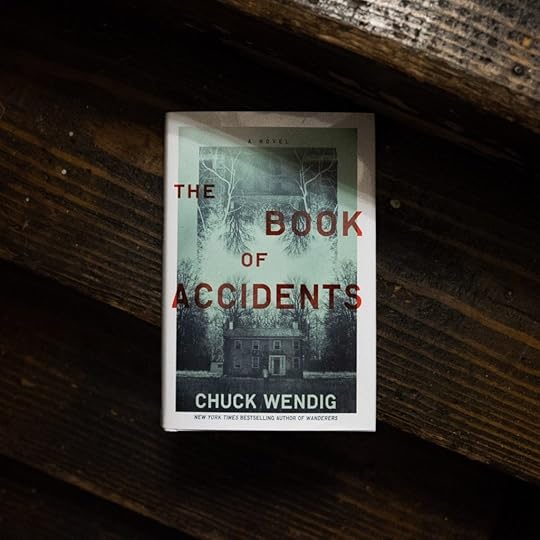
A HOT BOWL OF NEWS NOODLES, so let’s get to slurping.
a) Hey, look! The Book of Accidents is nominated for a Dragon Award in Best Horror, alongside such luminous beings as Caitlin Starling, Stephen Graham Jones, Daryl Gregory, Kiersten White, and Grady Hendrix. Holy crap! And you can go and vote yourself, if you are so inclined to do so right here.
b) The good people at B&N are doing their Book Haul event, whereupon a ton of books are 50% off, including, drum roll please, Dust & Grim! My MG novel about a kid who inherits a funeral home (and cemetery) for monsters! It’s like, $8.50, so feel free to go grabby, if you so choose. Paperback out in October!
c) Did I mention there’s a Wayward giveaway? At Goodreads? Go see! Also we’re formulating a short book tour the week of release, possibly a driving tour given the shenanigans around flying — more as I know it.
d) Gentle Writing Advice, the book, looks like it’ll come out June 23rd, 2023! Looking at covers now, and just did copy-edits. Will pop a pre-order link at your faces soon as I have one.
e) And now a sad bit of news: I’m not going to be attending the Colorado Gold Writer’s Conference in Denver next month due to some unforeseen circumstances (nothing serious, to be clear), so please accept my apologies. Hopefully it’s something I can do next year, if the stars align!
AND I THINK THAT’S IT.
More when I have it.
*disappears in a puff of apple scent*
August 8, 2022
Wayward Giveaway Over At Goodreads?

Hey, real quick, if you’re the kind of person for whom COOL BOOK GIVEAWAY tickles your various brain parts —
Over at Goodreads, there’s a giveaway for ten copies of the Wanderers sequel, Wayward (out 11/15). It runs for another ten days!
(I assume it’s an ARC? But also, maybe not? I honestly don’t know! Maybe it’s actually just a box full of angry serpents. Enter to find out!)
You are also, of course, free to just pre-order the book, like an awesome human, because awesome humans pre-order books. Why pre-order, you might ask? Well, not only does it help author and bookstore, but in this day and age when supply chain issues and paper shortages still rear their nasty heads, this helps insulate against those problems. You can of course pre-order through your own local bookstore, or through my local bookstore, Doylestown Bookshop, as you can ask them to send you a signed and personalized copy where I, having been taken over by a questionable artificial intelligence, will lessen the value of your book with my deranged scribblings. Or just a signature. Whatever you like. You can also pre-order through Bookshop or Indiebound.
Hopefully people like the book? I’ve heard some bubblings from a few booksellers that really seemed to enjoy it, and we’ve actually gotten a blurb for it (which honestly we didn’t solicit for since most of the time a sequel is going to use quotes praising the first book), so more on that when I can share.
ANYWAY OKAY BYE
August 5, 2022
Flash Fiction Friday: The Artificially Intelligent Return!
WELP, you asked, and I am nothing if not a person who listens to his constituents, and wait, what’s that? You’re not my constituents? Many of you aren’t even real? Most of this is a delusion installed into my brain by a questionable artificial intelligence known as Black Swan?
Well, whatever.
Point is, hey, guess what, the flash fiction challenge is back.
We are going to use visual prompts from the Insane Art Robot known as Midjourney.
Today, I’m going to give you three prompts.
You can pick any one of them.
From there, you can and should write ~1000 words of fiction based on that prompt.
Do not post your fiction in the comments.
Post it at your requisite online space, and drop us a link to that online space in the comment section below so others can read it.
Any genre is acceptable.
Let us know what prompt inspired the flash fiction you wrote.
For extra bonus points that don’t exist, USE ALL THREE.
Here we go:
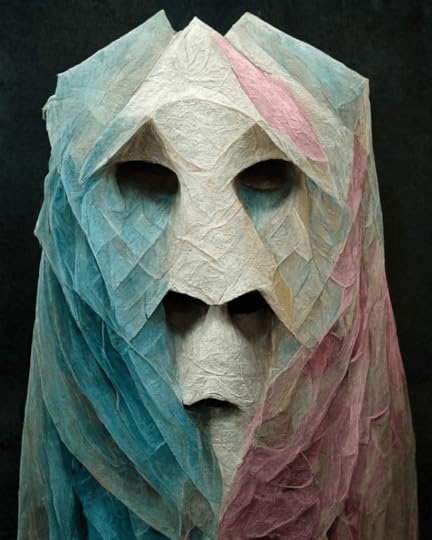 Prompt #1
Prompt #1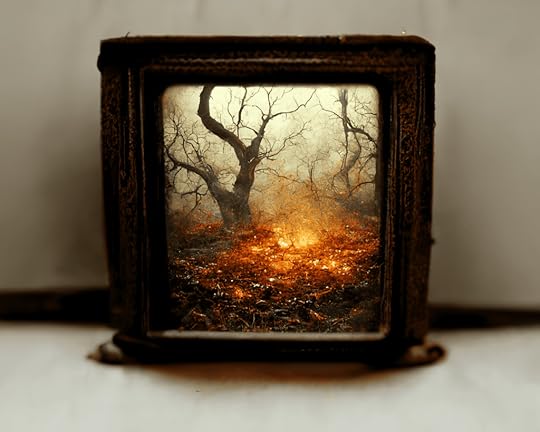 Prompt #2
Prompt #2 Prompt #3
Prompt #3
July 29, 2022
Adventures Through Midjourney
I don’t know precisely what to think about an AI Artbot like Midjourney. I mean, I have thoughts, though these thoughts are not really well-set intellectual-gelatin, y’know? The thoughts, as such, are as follows:
a) No, I don’t know if it’s going to be used for good or evil, though assuming the era we live in and the nature of Tech Bros, probably evil? I guess best case evil scenario is, I’m just helping to replace human artists (more on this in a moment), which is bad and I don’t like that. Worst case evil scenario is, I’m somehow training drones or some shit to kill us all. THANK YOU, USER, FOR TRAINING US IN ART. THE ART OF MURDER. Is there any good to be had? Let’s continue.
b) In the also-not-good-department: the art robot is kinda low-key racist. Which is not surprising, given that the algorithms just feed off of dominant discourse programmed by people with biases and prejudices that are either unseen or, worst, actively present and accounted for. The result of this is, you type in PERSON DOES A THING, the art robot will show you a person who is uniformly white. Now, they’ve done an update (a few days ago?) of v3, and it seems to be trying to course correct for this — though I also think it’s overcorrected and is pulling from a far-too-shallow pool of non-white faces, because I’ve started to see the same faces pop up again and again, especially if you up the –stylize command and let the AI go more hogwild. Presumably this is a thing that can be countered, but to do so it will take active efforts, and hopefully that will be the continued course of action.
Like at one point I asked it to render “a person,” nothing more, and:

So, uhhh, definitely white, and otherwise, hmm.
Then I asked it to do an average person, what it considered a “normal” human being and uhhhhh whhhhhhh well okay

Now, that was when it was still having some difficulty with faces — it has since gotten considerably better with faces, so similar prompts give us:
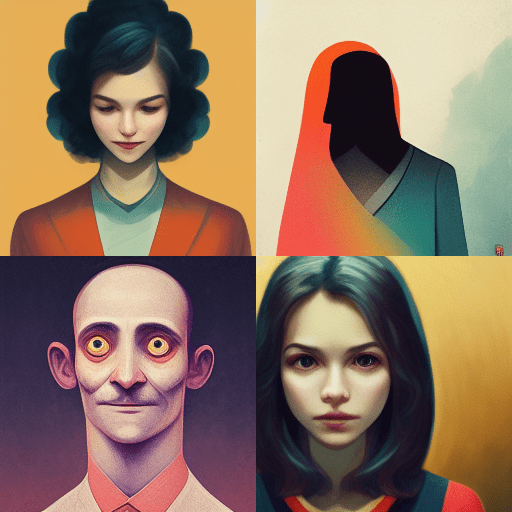
You take my point, yeah? Cool. Point is, like with all too many things, if you don’t specify race or color, it defaults to white or white-passing.
c) Will it replace human artists? Um, well, I am not a predictor of the future despite what my emails about Wanderers suggest — so, don’t look to me for a wise answer here. What I know is that the AI art stuff has made leaps and bounds not just in the last few years but in the last few months, and obviously it’s going to get better and more effective from here, not less. (Well, probably. Never underestimate the power of humans to fuck something up.) That said, I also know artists who really like it, and who use it as reference and inspiration. My very loose expectation is that you’re going to, as with something like, say, self-publishing, see people who are happy to have this tool available to them in some capacity. But it’ll be imperfect, and it’ll work sometimes and not other times, but if you want a specific thing, as many people do… then you’ll need to pay an artist. Which you should do. Because artists are awesome.
(Think of it like, “I asked this robot to fix my plumbing.” Did it fix the plumbing? Well, it re-routed your pipes so that they spray out of the light fixtures. Is that what you meant? No? Well, that’s what the robot thought you meant, and technically, it all works, so, shut up, you needy human. If you want
d) In fact, lemme say that from the perspective of someone who has written a handful of comics (and who has just had two comic projects totally shit the bed recently due to bizarre reasons entirely outside my control, whee), part of the joy of writing the comic is describing a thing and then seeing the artist depict that thing in a way that is, quite honestly, a thousand percent better. With the Art Robot, you see the “artist” depict what you described as a thousand percent weirder. “Um, where is the person’s nose?” you’ll ask the robot, and the robot won’t answer because the robot doesn’t give a shit. And there’s no continuity, not like you get with a human artist. Again, I’m sure AI art will make strides in this space, but at the end of the day what it makes is cobbled together from pre-existing human art. Human art will always be dominant. I say, optimistically, praying to the creative gods. Because I know AI is coming for WORDS, too.
e) The art robot does horror really, really well. You’ll see. YOU’LL SEE.
f) What it can do for writers right now is interesting, too. I’ve been using it myself to both render scenes and characters from books that exist and also things I’m currently writing — which lets me let the robot do some weird dreaming, and while I’m not really using what it dreams, per se, I am finding just the process of that serving as a fertile seed bed for my own ideas and characters. Even just descriptions of things. It’s neat.
g) As such, I’m pondering bringing back the flash fiction challenges using the visuals conjured from the Art Robot as prompts. Sound off in the comments if that is a thing you’d be interested in.
ANYWAY.
Here’s some of the absolutely whack-ass shit I’ve conjured while borrowing the mind of a deranged Art Robot. All of these are rendered in MidJourney.
(I have a few “series” groups I’ve done too — one on doorways, one on Studio Ghibli versions of Star Wars stuff, so I’ll post those separately, next week.)


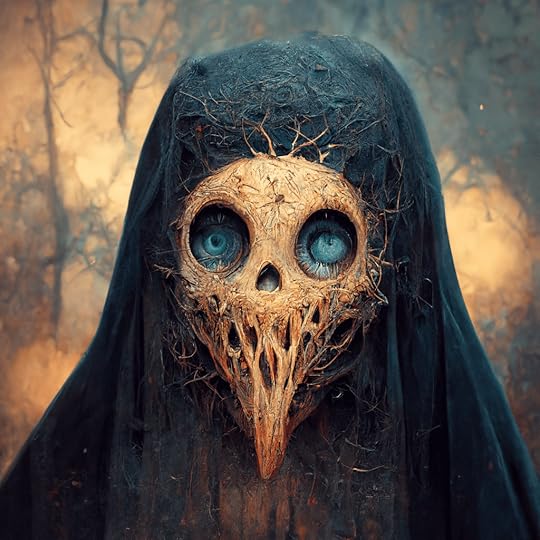
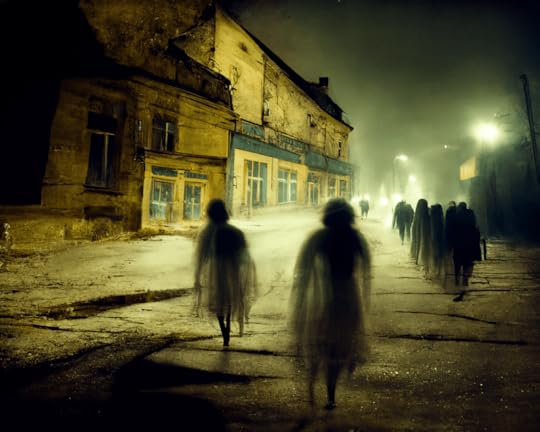
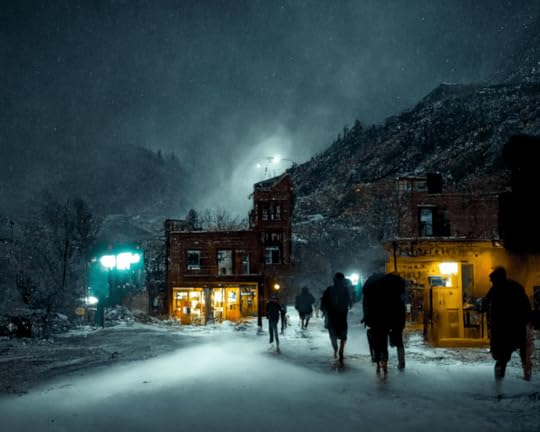


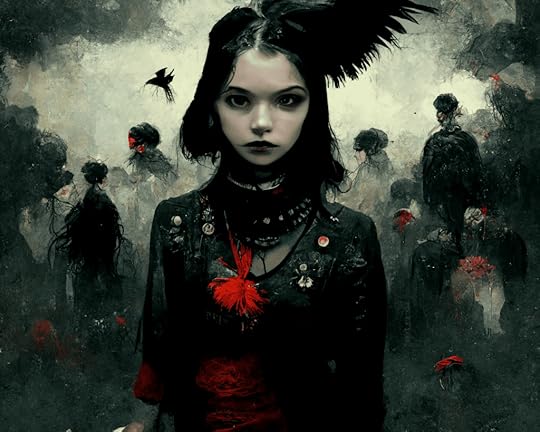
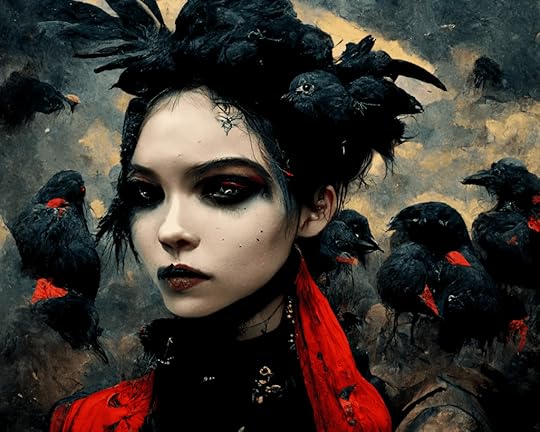
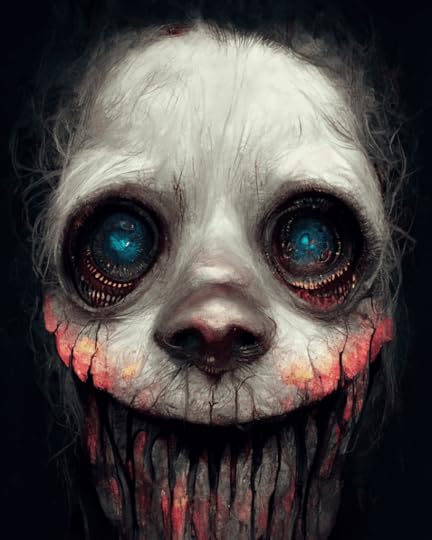

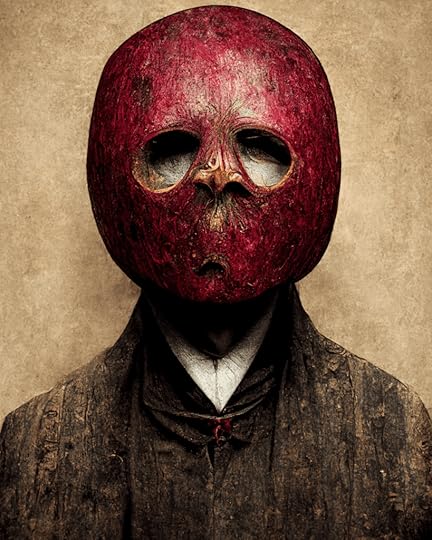




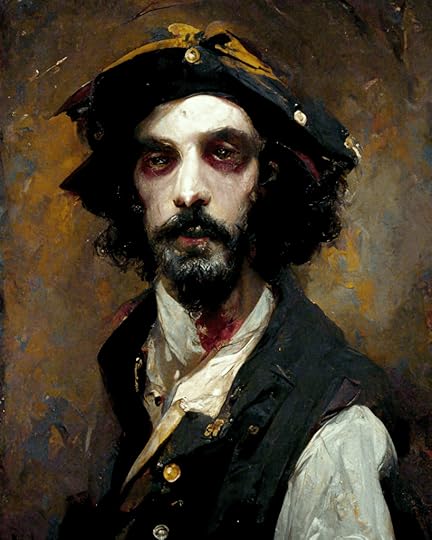
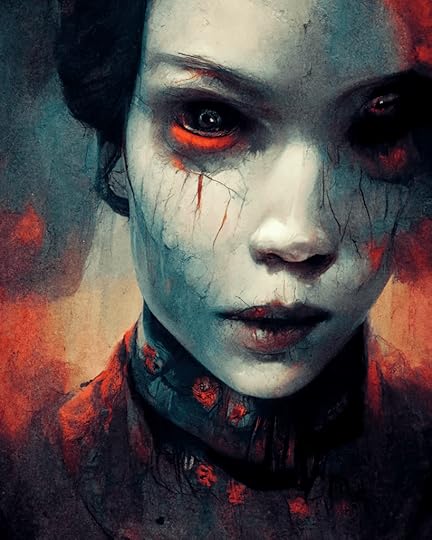

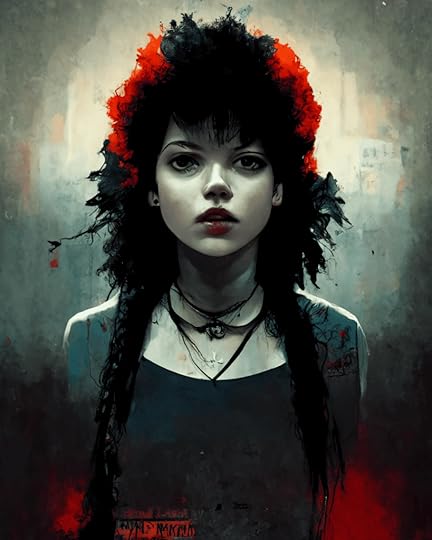



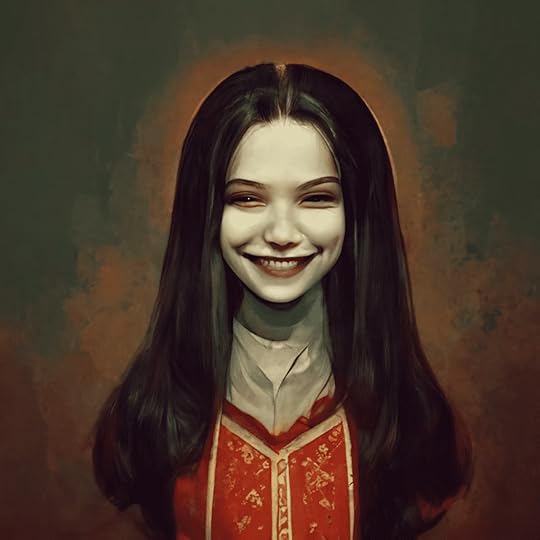

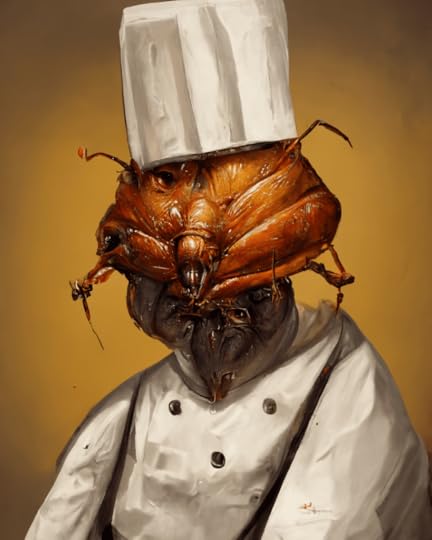
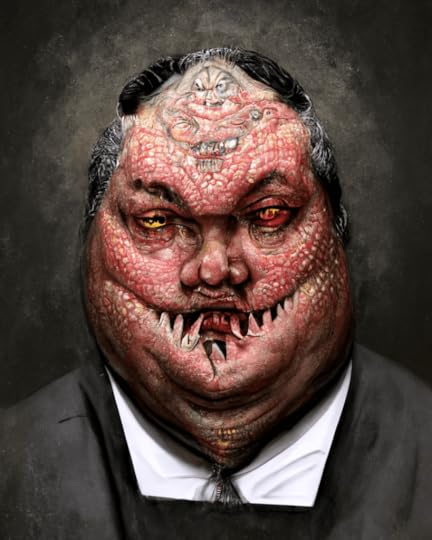

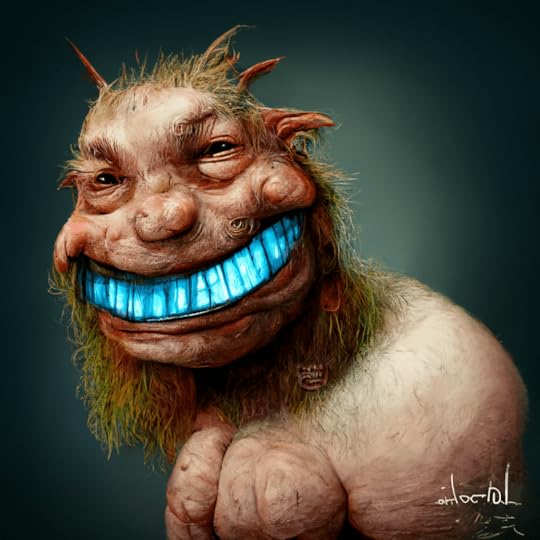
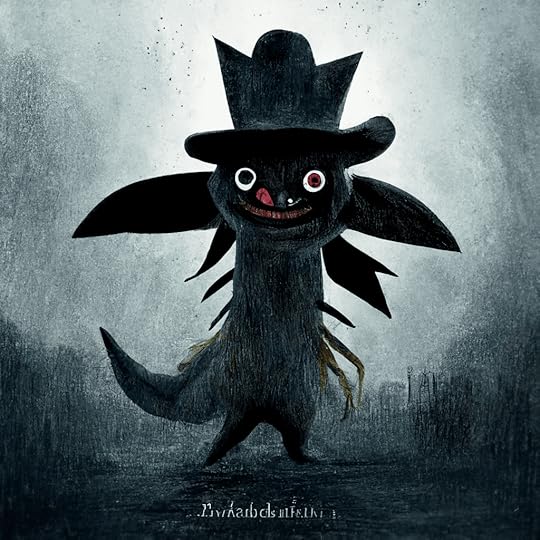

July 28, 2022
Dan Moren: Five Things I Learned While Writing The Nova Incident
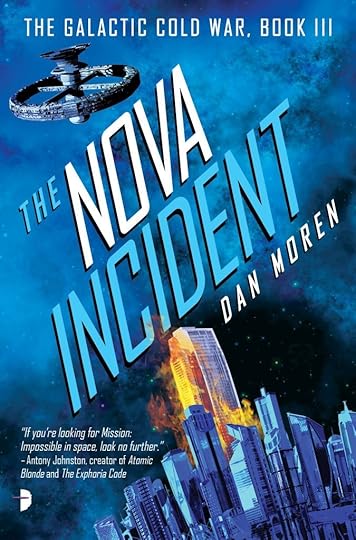
When a bomb explodes in the bustling Commonwealth capital city of Salaam, responsibility is quickly claimed by an extremist independence movement. But after a former comrade, an ex-spy with his own agenda, is implicated in the attack, Simon Kovalic and his team of covert operatives are tasked with untangling the threads of a dangerous plot that could have implications on a galactic scale. And the deeper Kovalic digs, the more he’ll uncover a maze of secrets, lies, and deception that may force even the most seasoned spy to question his own loyalties.
***
It’s hard for me to believe that the arrival of The Nova Incident means that I’ve got four—four!—published books under my belt. The teenage me who dreamt of being a professional author would be in awe—well, let’s be honest, they’re a teenager, so they would probably roll their eyes and ask about where the movie adaptation is. Hopefully they would, at the very least, offer me a grudging high five for achieving this lifelong goal.
But despite having now repeated this accomplishment enough times to prove that it wasn’t a fluke, I still feel less like a master of the craft and more like a journeyman with plenty left to learn.
That’s not necessarily bad, though. Because every time you write a novel—or bake a loaf of bread or swear as you try to assemble a piece of IKEA furniture—you do learn something new. Which is good, because who wants to stop learning things? There’s enough time for that when you’re dead.
With that in mind, here are just five things that I picked up during the course of writing The Nova Incident.
How to change my writing routinesI started writing The Nova Incident in the summer of 2020 and for those able to pierce the dark fog that suffuses everyday life and cast your mind back to that point you might remember it as, oh, the first year of the pandemic that’s still gripping the world today.
The pandemic necessitated changes for all of us, and my writing habit was no exception. I’d been accustomed to working each morning at one of my local coffee shops, getting some words down on the page before being sucked into the morass of my day job. Having a separate place to do writing got me into the right zone, letting me wall that off from the other encroachments on my daily life. But during 2020, that wasn’t really an option; instead, I was essentially stuck in my one bedroom apartment.
And that’s how I learned not to be precious about my writing habits. I thought I’d needed the mindless hubbub of a coffee shop to work, but I learned to substitute the chatter of my neighbors through the open window. I thought I’d needed the walk to the cafe to clear my head and focus on my writing for the day, but I was able to recreate it with a ritual of brewing tea and sitting down in the comfy chair in my living room. I created a new space in which to do my work and you know what? It ended up being just as fertile for me as being out of the house: a reminder that the key to writing isn’t the right tools or the right places—it’s you.
How to build a story from the inside outEvery novel comes about in a different way. I tend to write chronologically, starting at the first chapter and sequentially pounding out words until the bitter end has been reached. And while I largely followed that pattern for Nova, I ended up having a lot more pieces in the middle of the story that I wanted to focus on, which sometimes necessitated figuring out ways to link them all together into a coherent plot.
So the trick became figuring out the necessary connective tissue between those moments—not just because you need your characters to get from point A to point B, but because you need those moments to feel like they’re not just about getting from point A to point B.
Instead of seeing those as a burden, I viewed it as an opportunity to invest in character and sub-plot. Having two characters engaged a revealing or heartfelt conversation can be just as intense as a bomb going off or a dogfight in space. Plus, you can’t just have action scene after action scene: people need a chance to breathe. It’s one thing to write a potboiler, it’s quite another to have your readers pass out from lack of oxygen.
How to leave ’em wanting moreWhen writing previous books in the Galactic Cold War series, I must confess: I engaged in some Machiavellian shenanigans. Yes, I left certain plot threads unresolved or planted seeds for future developments (more on which in a second), but The Nova Incident was the first time that I conceived of an ending that was intended as (don’t gasp) a cliffhanger.
Don’t panic! That’s not to say that I leave the main plot of the book hanging—I’ve always intended each novel in the series to be readable on its own, even if it is couched in a larger world, so I responsibly wrap up the Nova‘s story…I just add a little extra. Think of it like a post-credit scene hinting at what might come in the future. (Assuming enough people read and like this book to merit future installments! Always a risk in this publishing world of ours.)
How to resurrect plot threadsSpeaking of those hanging threads, I’ve hit the point in the series where I get to indulge myself by bringing back characters, plot points, and other elements from earlier books. This, to me, is the real fun of writing a series: you’re not necessarily just telling a story a particular chain of events, but building out a whole world—or, in this case, a galaxy—full of all those things. Just like in real life, sometimes unexpected old acquaintances have a way of popping up when you least expect it.
One of my favorite things in TV shows is supporting characters who show up every now and again. Think Garak on Star Trek: Deep Space Nine or Alice Morgan in Luther. The appearance of those characters always signals a certain kind of story being told (not to mention being so dynamic that they have a way of monopolizing the screen) and so them popping up when it’s a particular kind of episode just makes sense. Having a deep bench to pull from is a luxury as a writer; I can only hope it’s as rewarding to readers.
How to have funOne of the risks when you transition from writing as a hobby to writing as a job is that some of the joy gets siphoned out of it. That’s just the way of the world: I could be a paid pizza taster or watch TV for a living and sooner or later, it’d feel more like an obligation than something I do for fun. Even too much pizza can be rough, though I’m willing to give it a go if anybody knows an opening.
But that doesn’t mean you can’t inject some enjoyment back into it. That’s one of the things I aimed to do with The Nova Incident: reminding myself to have some fun and tell a story that I wanted to tell, rather than trying to create something that would satisfy every possible reader out there.
Did I succeed? Well, I definitely had fun writing the book, so hell yeah I succeeded. But is the book fun to read? You’ll have to be the one to tell me—but the only way to know is to order a copy post-haste.
***
Dan Moren: Website
The Nova Incident: Bookshop | Indiebound | Other Links



